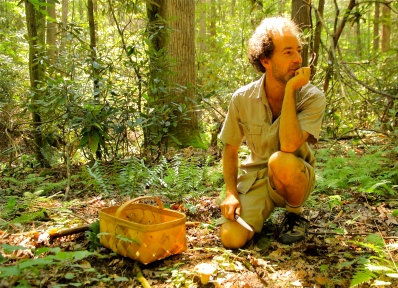By Paris Wolfe, Blogmaster, The Herb Society of America
If you’re making a weekend of the Herb Society of America’s annual meeting on April 29 in Asheville, consider going on a wild food adventure with No Taste Like Home. You’ll forage for wild herbs, “weeds,” and other edibles. Alan Muskat and his expert guides identify what’s edible and common, how to tread lightly, where it’s legal to forage and how much, proper preservation and preparation, and much more.
 When I was about eight, I loved to lounge in the lawn behind my parents’ light green ranch home. The grass was mixed with clover (edible), dandelions (edible), plantain (edible), chickweed (edible), violets (edible), purslane (edible), ground ivy (edible), onion grass (edible). Who knew I was laying in the salad?
When I was about eight, I loved to lounge in the lawn behind my parents’ light green ranch home. The grass was mixed with clover (edible), dandelions (edible), plantain (edible), chickweed (edible), violets (edible), purslane (edible), ground ivy (edible), onion grass (edible). Who knew I was laying in the salad?
In the good old days, the lawn could be a first course. Not so much today with chemically cultivated homogenous grass. For many reasons, the perfect lawn became a middle-class American standard and gone was any connection to some of the most sustainable, locavore foods.
Reclaim that culinary heritage with a foraging hike in Asheville, NC. Alan Muskat’s wild food tour company, No Taste Like Home, has 30 private hiking spots scoped out to collect edible “weeds.” He has negotiated permission for all of the sites.
 In January, when we visited, our guide Abby Artemisia handed out little, brown paper bags, round basket with handles round baskets with handles and an affectionately labeled “brifes.” A “brife” is a combo knife and paint brush for picking and cleaning specimens. Ours is a duct-taped prototype that may be followed by the real thing.
In January, when we visited, our guide Abby Artemisia handed out little, brown paper bags, round basket with handles round baskets with handles and an affectionately labeled “brifes.” A “brife” is a combo knife and paint brush for picking and cleaning specimens. Ours is a duct-taped prototype that may be followed by the real thing.
 We spent three hours stepping around the ten acres surrounding Alan’s home in the mountains a few miles east of downtown Asheville. There we found more than 20 herbs and edibles. An amazing number for a dormant season.
We spent three hours stepping around the ten acres surrounding Alan’s home in the mountains a few miles east of downtown Asheville. There we found more than 20 herbs and edibles. An amazing number for a dormant season.
Among these were white pine needles that are used for seasoning and tea and wild rosehips that are good by themselves, in preserves, or made into tea. Just when it seemed everything was edible, Abby pointed out a few poisonous leaves and berries to avoid as well.
When the hike was over, Abby distributed a sheet to record our “catch of the day.” It listed possibilities found in other seasons such as ramps, wood nettle, autumn berry, and so much more. The list noted which can be particularly hard to identify and which must be cooked.
If we scored 20-plus in mid-winter, imagine the menus you can build with a mid-summer’s collection of mushrooms, berries, flowers and so much more.
Speaking of menu, you can even take your harvest to one of four Asheville restaurants where a top-name chef will transform it into a free appetizer. Kind of like Iron Chef meets Survivor Man.
Creating No Taste Like Home is part of Alan Muskat’s journey to  self-actualization.
self-actualization.
About 25 years ago, studying philosophy at Princeton, the Miami native of Cuban ancestry first went hiking, learned to cook, and discovered taoism. These three encounters led to an interest in natural foods. At that point, Alan’s next comment is no surprise: “I decided to drop out, become a hippie and live off the land.”
In the best sense of doublespeak, he continues: “Foraging means taking things as they come. It was grounding for me. It gave me a sense of abundance.”
No Taste Like Home began, quite simply, because Alan ran out of money. “I fell into it,” he says. “It was an outgrowth what I was already doing for myself. No one else was doing it and I thought, ‘I can teach this.’ I must have gotten the jump on the trend, because in the past three years, my business has twice doubled.”
Pausing, he says that for many reasons, the growing interest in wild food is really inevitable. “We have to get back to what’s truly natural. Even organic agriculture is neither local nor sustainable unless you’re growing what would thrive there on its own.”
Alan is working with Asheville schools to dispel any stigma about “eating weeds.” His company is offering a seven-month training program, starting this April, for people who want to learn to be wild food instructors, whether with his company or elsewhere.
It’s hard for Alan to pick a top wild food. He compares one of his favorites – autumn olive juice – to lychee fruit. He sings the praises of what he calls fairy potato (commonly known as cinnamon vine). But mushrooms top his list. Or, then again, maybe it’s amaranth…
What’s your favorite wild edible? Favorite wild herb?


Pingback: We Rank First In Top 30 Herbal Blogs – The Herb Society of America Blog